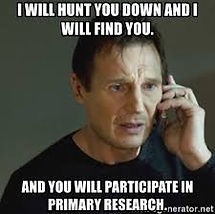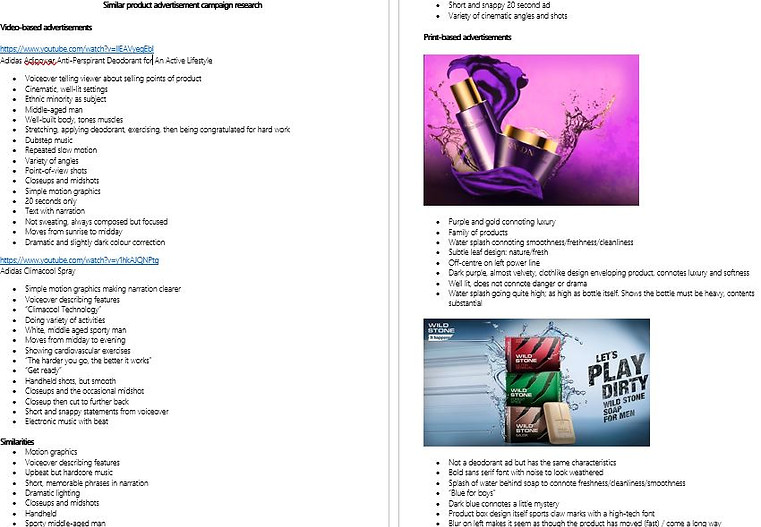PRIMARY RESEARCH

Primary research is research you conduct yourself through first-hand experiences to answer specific questions you want answered. It is described as "new research" because it is data nobody has ever collected before (although similar data may have been).
There are a few methods researchers employ to collect primary research. Let's go through them.
-
Interviews, focus groups, online interviews (qualitative)
Interview/online interview: a one-on-one recorded conversation where an interviewer asks the interviewee questions that they have to answer. This allows for highly in-depth responses because the interviewer can give prompts or probe the interviewee to expound upon thoughts and deliberate further.
Focus group: a group of people whose responses are studied as if they were representative of a larger population. A stratified sample of people are used (normally respondents of a questionnaire), and researchers try to include a demographically, psychographically, and socioeconomically diverse group of people.
Illustrative example: focus group
We would like to gain a more in-depth idea of the potential audience for our film.
Before the meeting
-
Before we begin, we must make sure a focus group is actually what we need and will actually be of use. We ask ourselves:
-
Why are we conducting a focus group?
-
What do we hope to learn?
-
Are there any other methods to collect this data? Are they better or worse, and why?
-
How long will this take? How expensive will it be?
-
How many people will we recruit? Who will they be?
-
Who will facilitate the group and why? Do they have experience? How do they speak? What do they look like? The person who leads the focus group can have an enormous impact on the responses.
-
-
Once we have concluded that a focus group is exactly what is required, we can begin to prepare for it. We can send out a questionnaire with close-ended and limiting questions, to collect (mostly) quantitative data. Now that people can be put into separate demographic groups, psychographic groups, genders, ages, ethnicities, etcetera, we can pick one person from each (or more) for our stratified sample, in the hope that they are good representatives of the entire population. We try and choose people who are more vocal and actually think about our questions, and also fall within our target audience - teenagers.
-
We might have to decide on incentives for people to attend. What's in it for them? Is it money, benefits, a gift, or something else entirely? Nobody will want to come if they aren't rewarded for their time. When advertising, we have to stress our benefits.
-
We prepare some questions in advance, so there is little improvisation during the actual interview. We could also prepare to show them something (say, a piece of film) and study their responses.
-
We decide on the meeting particulars, namely
-
Where?
-
When?
-
How long?
-
How many times? Etcetera.
-
During the meeting
-
We begin with the formalities.
-
Thank people for coming.
-
Introduce the topic; set the stage.
-
Explain the structure of the meeting.
-
-
We begin with a general, open question. This sets the tone.
-
When looking for more depth in answers or validating responses, we can
-
Rephrase questions.
-
Ask follow-up questions.
-
Repeat what we have understood from a response, and make sure the respondent agrees with what we said we have understood.
-
Prompt or put slight pressure (e.g. through eye contact) with those who have not spoken.
-
Speak louder; enunciate our words; speak slower
-
Ask whether anyone has anything more to say. This will allow them to express anything they haven't been able to yet.
-
-
We make sure we record the interview, so we can always go back for more. Later on, we can transcribe the interview as well so we can use quotations.
-
We keep the conversation going.
-
We make sure we don't go overtime. Ten to twenty minutes is enough, depending on how many people there are and what the topic is.
Ending the meeting
-
We inform the group of what to expect later on. We might have to call them back, send out a follow-up survey, or contact them again.
-
We ask whether anyone has any comments.
-
We thank everyone for their time.
After the meeting
-
We transcribe the recording and take notes of recurring themes.
-
We can use a 'scoring' system to measure the frequency of recurring themes. This can be used as quantitative data.
-
-
We identify patterns.
-
We identify any new questions we now have.
-
We make note of any conclusions we seem to have.
-
We might want to share some information with the group - they gave us their time; we can give them ours and give them the piece of mind that we have not manipulated anything they have said. They may also genuinely want to know what we understood from them.
-
We can also apply the same protocol to an interview, which would yield far more in-depth information. We will have to conduct multiple interviews, however, to get a better picture.
Interview example (shortened) Focus group example
-
Observations (qualitative and quantitative)
To observe is to closely monitor phenomena in an unobtrusive method (i.e. we do not influence the results like we do when asking questions, for example).
When we observe, we could be:
Watching someone's reactions to something we show them (such as a film)
or
Identifying and tallying (e.g. counting the number of taxis that drive by)
or
Participating in an activity and making note of its characteristics. This is called participant observation and allows for us to go further than simply observing from a distance.
or
More extreme - completely immersing ourselves in the lifestyle of our audience. This is called ethnographic methodology, and can be extremely lengthy but incredibly revealing.
-
Questionnaires, surveys (quantitative)
These provide us with (mostly) quantitative data for statistical study. We ask a set of printed questions and the respondent answers them.
How to: questionnaire
-
Make it professional. Nobody will be bothered to give you their time if you didn't put time into making the questionnaire look nice.
-
Start with a filter question (yes-or-no). If the answer is no, the respondent is probably not of use. Thank you for your time! Goodbye!
-
Use close-ended (yes-or-no) or limiting questions (open question with limited choices, often a scale from 0 to 10).
-
Break questions up into clear sections. Structure your questionnaire so it makes sense.
-
Allow development with a space for final comments at the end. If someone has anything to say, they have the option to do it here.
-
Send it to people in your target audience. Don't waste others' time if you don't need their responses. Make sure your recipients represent the whole population; an equal number of males and females, age groups, etcetera is required.
-
When you get your responses, sift through them and only keep the useful answers/questions. Present only this data.
-
Write a conclusion about what you learnt at the end.
Illustrative example: questionnaire
We would like to find out whether there is demand in the market for a bicycle indicator light.
Questionnaire extract:
-
Internet forums, social media (qualitative)
Although informal and not very reliable, this can be a quick and easy way to gather information online. Many may care to write in detail if they feel strongly about a topic.
Often used to get an idea of expected responses from more reliable research techniques and write new questions based on responses. Have a look here for an example.
-
Self-generated: photos, sound recordings, readings (qualitative and quantitative)
This is evidence that can be used for analysis. It requires no interaction with other people; it is a study of simply what already physically exists.
For example, a researcher might take pollution level readings in different locations at different times to investigate the need for an air purifier. Have a look here for an example. This is a site analysis; a little different.
-
Desk research (qualitative)
Desk research is a form of production research; it allows you to learn and analyse aspects of finished products that already exist. This form of research will allow you to familiarize yourself with the nuances, styles and techniques of production, answering an important question of how was it made?
Desk research is critical because it is a very effective way to acquaint yourself with existing work, because, as a researcher, you are able to directly engage with the media. This type of research is also relatively cost effective, although it could be a lengthy process.
Often, desk research lends itself to taking place online or through texts.
Questions often answered by desk research are both qualitative and quantitative. For example, numeric data like box office takings, star-ratings, budgets, etcetera can be found by means of desk research. Qualitative, opinion-based data like critic reviews, production techniques, and more is also collected through desk research.
Viewing existing film or print-based work is also part of this form of research.
It is not uncommon to take notes while analyzing existing work; this helps to become conversant about what you plan to make.
Illustrative example: desk research
We would like to learn about the different genre conventions of teen dramas.
How to: desk research
-
Identify what it is exactly that you are making. Then find pieces of work that already exist that are similar to what you are making.
-
Make a list of these pieces of work. 5 titles are good.
-
-
Watch and analyse these pieces of work. You MUST be taking notes - not only does this make it easier to document everything you have identified, but it makes communication with others a lot easier.
-
Make sure you are undisturbed and are concentrating. Make notes on things like
-
Cinematography
-
Dialogues
-
Sound
-
Editing
-
Colour grading and correction
-
Angles
-
Mise en scène
-
Clothing, etcetera.
-
-
You can also find out quantitative data like
-
Duration of existing films
-
Ticket price of existing films, etcetera.
-
Desk research notes extract
Click to enlarge








